COVID-19 and Educational Activities
The core hypothesis of this research is that the current setting and obstacles adversely influence schoolchildren’s level of physical activity.
Literature Review
- Keywords for articles: “COVID-19,” “coronavirus,” “pandemic,” “school children,” “physical activity,” and “mental health.”
- Databases: PubMed, Elsevier, Wiley, and Google Scholar.
- First question: patterns of online education.
- Kanik (2021) conducted a mixed-method study focused on students, but it contains almost no empirical data.
- Gupta & Jawanda (2020) focus on the correlation between the socio-economic status disparity and access to education, highlighting a possibility of a new social crisis.
The outbreak of the COVID-19 pandemic has dramatically changed people’s lives, setting standards of self-isolation. Due to this, there is a need to assess the impact of various restrictive measures on schoolchildren’s health.
In this regard, the hypothesis for this research project is that the current educational setting, social distancing, and reduced physical interactions form a negative trend towards schoolchildren’s level of physical activity.
A study of the literature and various academic approaches was carried out to investigate this issue. First of all, attention was paid to the subject of the attitude of schoolchildren to the patterns of online education.
Kanik (2021) showed that despite positive trends in academic performance, students are dissatisfied with the lack of access to the campus and the lack of live communication.
Gupta & Jawanda (2020) analyzed the correlation between socioeconomic status and access to education. According to these analyzes, the pandemic is a precedent for the emergence of a new social crisis.
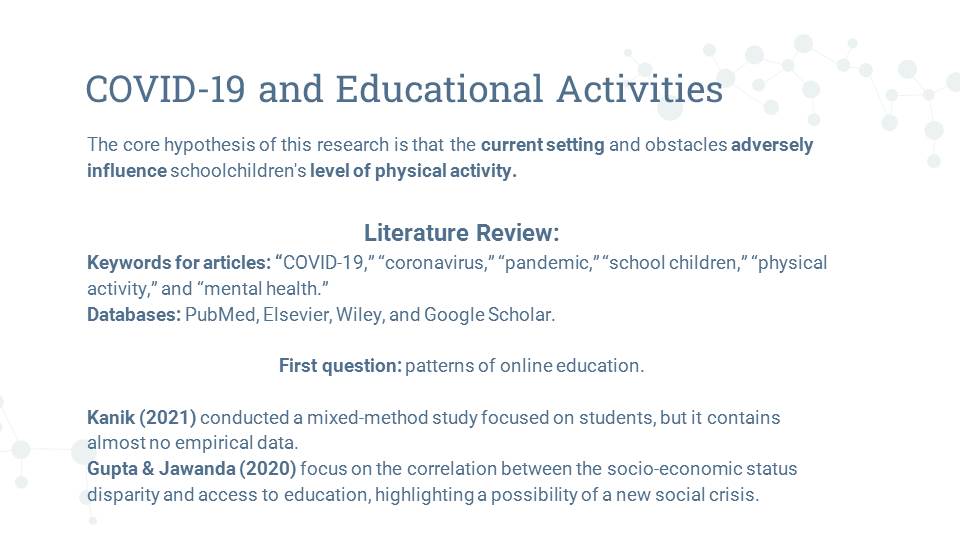
The Impact of COVID-19 on Mental Health and Physical Performance
Second question: impact of socioeconomic differences and social exclusion on physical and mental health indicators.
In a cross-sectional descriptive study, Araby et al. (2021) collected online questionnaires from parents. However, its implications may be biased as families reported the data without quantitative evidence.
Cross-sectional studies by Alzahrani et al. (2021) and Puccinelli et al. (2021) indicate a positive correlation between exercises and health-related quality of life but focus on adults.
Mixed-methods research by Gilbert et al. (2021) and systematic review by Okuyama et al. (2021) proved a similar hypothesis for children but used data from their parents.
The following research question is the impact of socioeconomic differences and social exclusion on physical and mental health indicators.
Araby et al. (2021) showed that the COVID-19 pandemic had a significant adverse influence on children’s sleep and eating patterns.
Other studies have examined the correlation between physical activity and psychological well-being. Alzahrani et al. (2021) and Puccinelli et al. (2021) confirm the hypothesis that the more a person engages in physical activity, the lower their stress level.
Using parental reporting as a data collection technique, Gilbert et al. (2021) and Okuyama et al. (2021) demonstrated that similar hypotheses are valid for children since maintaining the level of physical activity improves their psychological state.

Physical Activity Rates and COVID-19 Implications
Third question: general patterns of physical activity during a pandemic.
A cross-sectional study by Bakhsh et al. (2020) revealed that 50% of respondents lowered their physical activity during the pandemic.
A literature review by Tan (2021) shows that prolonged school closures resulted in a reduction in children’s physical activity.
A cohort study by Pavlovic et al. (2021) confirms this fact by surveying school PE teachers, administrators, and nurses, 80% of which highlighted a decrease in terms of PE requirements.
The available literature lacks objectivity in data collection but shows a significant influence of the pandemic on physical activity.
Finally, the last issue to be considered in the research context is the general patterns of physical activity during a pandemic.
Thus, Bakhsh et al. (2020) found that nearly half of the people surveyed began to exercise less during the pandemic. However, unlike adults, children cannot be fully responsible for their physical health, as Tan (2021) argues, citing extended school closings as the reason for the sharp decline in children’s physical activity.
According to Pavlovic et al. (2021), this is confirmed by school workers themselves, speaking about the restrictions in PE requirements. Finally, an additional argument is provided by parents’ claims of a shift from structured to unstructured activity.
Thus, improving the condition of children cannot be achieved without opening schools, which is a top priority for many government agencies, despite the vastness of the resources required.
Studies show that the pandemic has a powerful influence on the mental and physical health of people. Nevertheless, to obtain more accurate information on the subject of physical activity of schoolchildren, further research is necessary, eliminating bias in the methods of data collection.
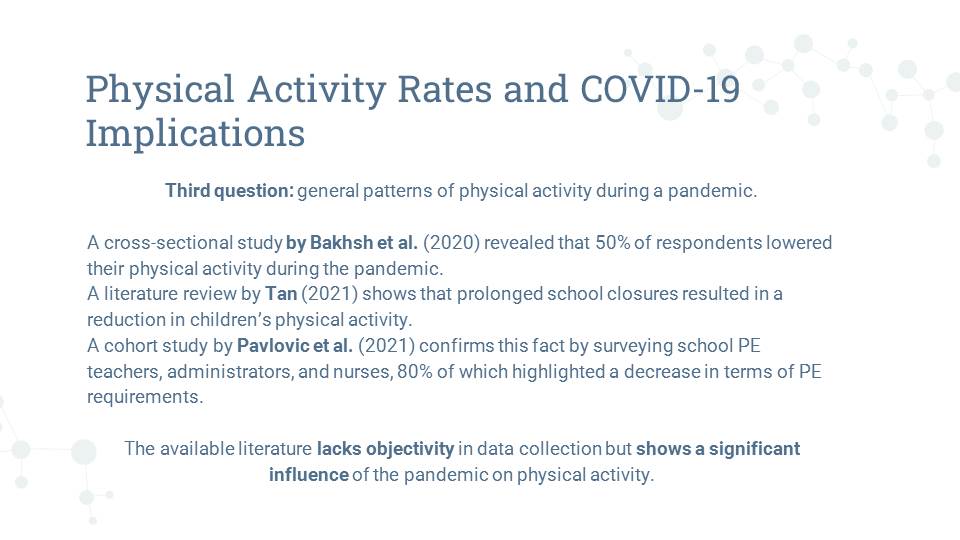
Suggested Methods
- Most of the current studies focused on adults instead of children, creating an inadequate quality of academic evidence on the topic. Current research will shift focus from the parents to children.
- The use of self-administered questionnaires on adults does not provide enough insight on the topic. Therefore, the current research will evaluate the children’s perception due to their responsiveness.
Analysis of the literature showed that most studies are limited in time and resources due to the pandemic. Because of this, the most popular of the considered methods was mixed-methods cross-sectional studies.
However, this creates an inadequate quality of academic evidence during the crisis. In the context of the topic under study, this manifests itself in using adults as a source of data.
Therefore, the priority of the current research will be to shift the focus from parents to their children.
Another obstacle to obtaining reliable information is the use of self-administered questionnaires.
According to research, the use of questionnaires and interviews on adults does not provide enough insight (Elyazgi, 2018). Therefore, they are better used for children aged six years and older due to their high levels of responsiveness.
Given these factors, the study’s methodology will concern a quantitative correlational study focused on evaluating the children’s perception of physical activity and developing a framework for its improvement.
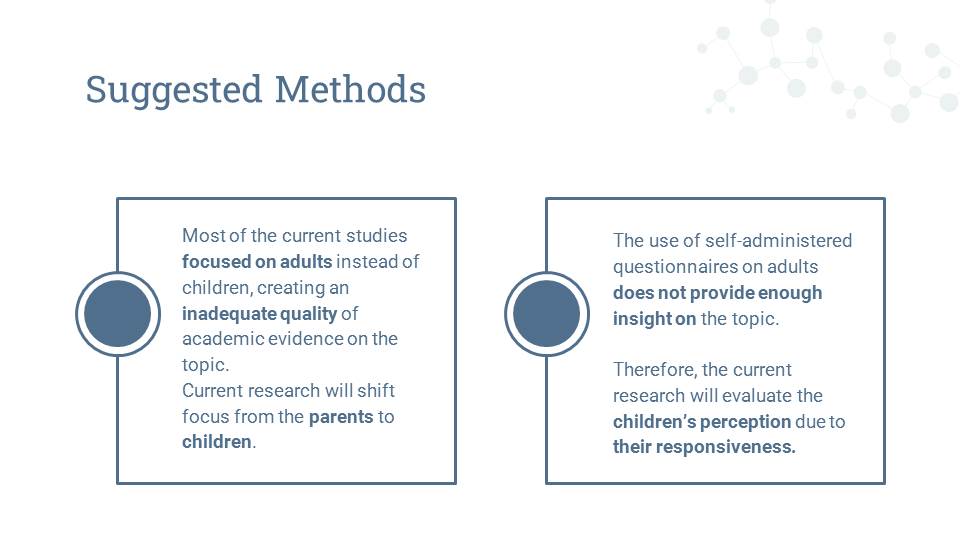
Data Collection and Analysis
Questionnaires: Adapted self-administered surveys will address physical activity rates and factors for its change.
Correlation Analysis: The analysis will be performed for potential correlation grounds: mental well-being, access to physical activities, amount of free time.
Sampling: Non-probability snowball sampling will be used to obtain 50 respondents. The SurveyMonkey platform will be used.
The first part of the study will focus on capturing primary data using self-administered questionnaires adapted for adolescents.
They will be created based on HomeSTEAD’s physical activity, considering including non-ambiguous statements, inclusive language, and a simple evaluation pattern.
Questions will address children’s physical activity rates before and during the pandemic and the reasons for the change in these rates.
The resulting data will be processed using descriptive statistics, mean, standard deviation. In addition, a correlation coefficient analysis by calculating an r-value for every potential correlation ground will be performed.
This will allow further development of a framework for improving physical activity, another part of the study.
For this analysis, non-probability snowball sampling will be used because of its effectiveness at the given time frames.
A teacher will be recruited by sending out online questionnaires in their classrooms to obtain approximately 50 respondents.
Survey data will be generated based on the SurveyMonkey platform for instant access to completed questionnaires and frequency distribution.
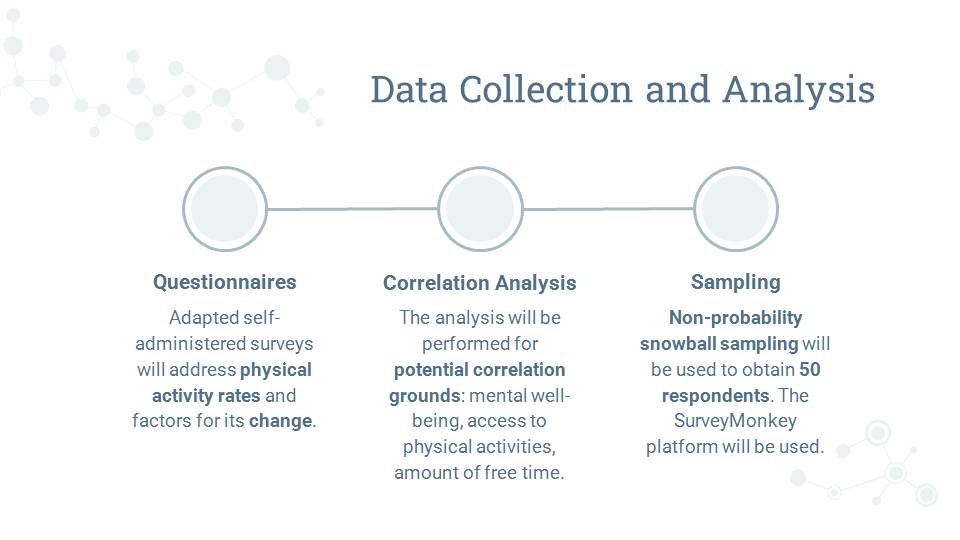
Expected Results
Hypotheses
- H0 – There is no correlation between the school children’s physical activity and such COVID-19 implications as mental well-being, school closure, access to physical activity, and outdoor time.
- H1 – There is a correlation between the school children’s physical activity and such COVID-19 implications as mental well-being, school closure, access to physical activity, and outdoor time.
Based on the results of the literature review and pandemic’s characteristics, there is a high probability of rejecting the null hypothesis.
The study outcomes will present a valuable insight from children’s perspective.
Two hypotheses are put forward related to the absence or presence of a correlation between the physical activity of schoolchildren and COVID-19 implications.
Since the pandemic affects almost all spheres of human activity, there is a high probability of finding a correlation, which coincides with the studied literature.
However, despite the already existing evidence of improved mental well-being with exercise, there is no research that can support the opposite. Therefore, the establishment of a given correlation is necessary to clarify the causes and implications.
Most of the available data focuses either on adults or guardians and parents, but not on children themselves. Thus, an additional expected result of this study is a higher quality of the data obtained, which differs from the currently available.
The outcomes of this study should provide more insight into promoting healthy lifestyles among adolescents in the context of the pandemic.
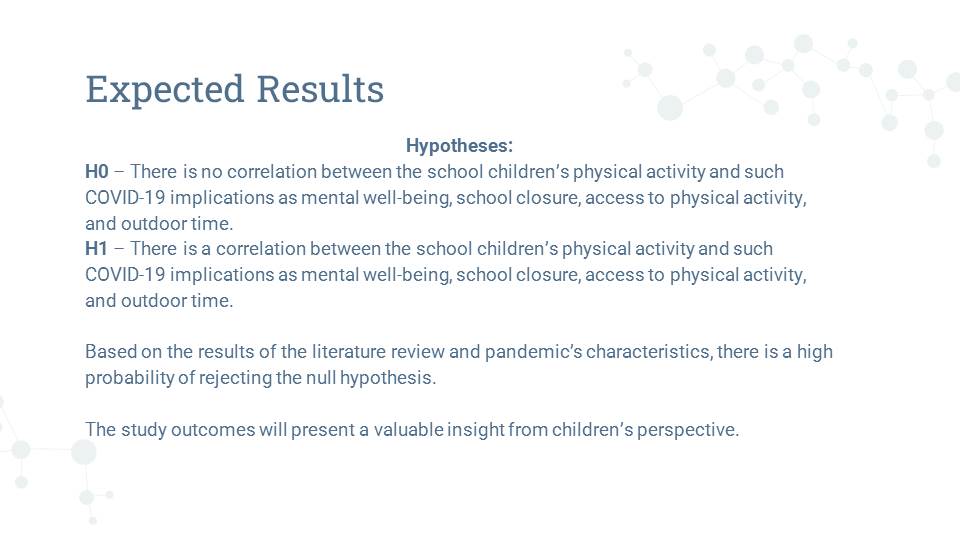
References
Alzahrani, H., Alshehri, F., Alsufiany, M., Allam, H. H., Almeheyawi, R., Eid, M. M., & Sadarangani, K. P. (2021). Impact of the 2019 coronavirus disease pandemic on health-related quality of life and psychological status: The role of physical activity. International Journal of Environmental Research and Public Health, 18(8). Web.
Araby, E. M., Emadeldin, E. M., & Zakaria, H. M. (2021). COVID-19 quarantine measures and its impact on the pattern of life of school children. The Egyptian Journal of Hospital Medicine, 82(2), 217-224. Web.
Bakhsh, M. A., Khawandanah, J., Naaman, R. K., & Alashmali, S. (2020). The Impact of COVID-19 quarantine on dietary habits and physical activity in Saudi Arabia: A cross-sectional study. BMC Public Health, 21. Web.
Department of Education. (2020). Education and children issues. Educational Journal, 434, 67-72.
Elyazgi, M. (2018). Review of gathering data instruments and methods in children research. International Journal of Engineering & Technology, 7(3.21), 311-316.
Gilbert, A. S., Schmidt, L., Beck, A., Kepper, M. M., Mazzucca, S., & Eyler, A. (2021). Associations of physical activity and sedentary behaviors with child mental well-being during the COVID-19 pandemic. BMC Public Health, 21(1), 1-12. Web.
Gupta, S., & Jawanda, M. K. (2020). The impacts of COVID-19 on children. Acta Paediatrica, 109(11), 2181-2183. Web.
Harrington, D. M., & O’Reilly, M. (2020). The reimagination of school-based physical activity research in the COVID-19 era. PLoS Medicine, 17(8). Web.
Hu, D., Zhang, H., Sun, Y., & Li, Y. (2021). The effects of the measures against COVID-19 pandemic on physical activity among school-aged children and adolescents (6–17 years) in 2020: A protocol for systematic review. PloS One, 16(7). Web.
Kanik, M. (2021). Students’ perception of and engagement in reactive online education provided during the COVID-19 pandemic. International Online Journal of Education and Teaching, 8(2), 1063-1082.
Lancker, W. V., & Parolin, Z. (2020). COVID-19, school closures, and child poverty: A social crisis in the making. The Lancet Public Health, 5(5), 243-e244. Web.
Lanza, K., Durand, C. P., Alcazar, M., Ehlers, S., Zhang, K., & Kohl, H. W. (2021). School parks as a community health resource: Use of joint-use parks by children before and during COVID-19 pandemic. International Journal of Environmental Research and Public Health, 18(17). Web.
Nathan, A., George, P., Ng, M., Wenden, E., Bai, P., Phiri, Z., & Christian, H. (2021). Impact of COVID-19 restrictions on western Australian children’s physical activity and screen time. International Journal of Environmental Research and Public Health, 18(5). Web.
Nelson, B. (2020). The positive effects of covid-19. BMJ, 369. Web.
Okuyama, J., Seto, S., Fukuda, Y., Funakoshi, S., Amae, S., Onobe, J., Izumi, S., Ito, K., & Imamura, F. (2021). Mental health and physical activity among children and adolescents during the COVID-19 pandemic. The Tohoku Journal of Experimental Medicine, 253(3), 203-215. Web.
Pavlovic, A., DeFina, L. F., Natale, B. L., Thiele, S. E., Walker, T. J., Craig, D. W., Vint, G.R., Leonard, D., Haskell, W. L. & Kohl, H. W. (2021). Keeping children healthy during and after COVID-19 pandemic: Meeting youth physical activity needs. BMC Public Health, 21(1), 1-8. Web.
Pelletier, C. A., Cornish, K., & Sanders, C. (2021). Children’s independent mobility and physical activity during the COVID-19 pandemic: A qualitative study with families. International Journal of Environmental Research and Public Health, 18(9). Web.
Puccinelli, P. J., da Costa, T. S., Seffrin, A., de Lira, C. A. B., Vancini, R. L., Nikolaidis, P. T., Knechtle, B., Rosemann, T., Hill, L., & Andrade, M. S. (2021). Reduced level of physical activity during COVID-19 pandemic is associated with depression and anxiety levels: An internet-based survey. BMC Public Health, 21(1), 1-11. Web.
Rochwerg, B., Parke, R., Murthy, S., Fernando, S. M., Leigh, J. P., Marshall, J., Adhikari, N. K. J., Fiest, K., Fowler, R., Lamontagne, F., & Sevransky, J. E. (2020). Misinformation during the coronavirus disease 2019 outbreak: How knowledge emerges from noise. Critical Care Explorations, 2(4). Web.
Štveráková, T., Jačisko, J., Busch, A., Šafářová, M., Kolář, P., & Kobesová, A. (2021). The impact of COVID-19 on physical activity of Czech children. PloS One, 16(7). Web.
Tan, W. (2021). School closures were over-weighted against the mitigation of COVID-19 transmission: A literature review on the impact of school closures in the United States. Medicine, 100(30). Web.
Torales, J., O’Higgins, M., Castaldelli-Maia, J. M., & Ventriglio, A. (2020). The outbreak of COVID-19 coronavirus and its impact on global mental health. International Journal of Social Psychiatry, 66(4), 317-320. Web.
Vaughn, A. E., Hales, D. P., Neshteruk, C. D., & Ward, D. S. (2019). HomeSTEAD’s physical activity and screen media practices and beliefs survey: Instrument development and integrated conceptual model. PloS One, 14(12). Web.